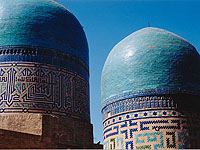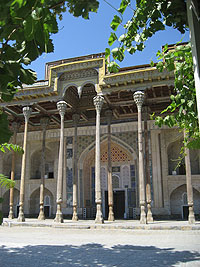 |
|
Uzbekistan - Milestones of History |
|||
|
By that time, rapid growth in trade was also observed, for example, between East and West along the well-established and safeguarded route of the Great Silk Road. The caravans carried silk, fur, varnished items, and many other things from China to the West. Trade with the Roman Empire also increased. The Roman-made items, discovered on the territory of former Bactria and Sogdiana, serve witness to it. In the 3rd century the Kushan Empire began to face its gradual downfall, and suffered a number of defeats from the Sassanid monarchies. By the 4th century, the empire no longer existed. Unlike the southern regions, the establishment of political units in the north of Uzbekistan began much later - the second half of 1000 B.C. One of the prerequisites that led to the union by nomadic and semi-settled tribes of the steppes and local agricultural oases served an invasion campaign launched by Alexander the Great in the area. The state formation, namely Kangyui, is traced back to 4th and 3rd centuries B.C, The state is reported to have been located on the territory of north Central Asia, Tashkent oasis, and Talas valley. The documentary evidence also reveals that the state had a large, well- trained army, which successfully withstood several enemy campaigns. Its population mainly consisted of Turkic speaking tribes. Some historians say that the new Turkic population and language was composed during that very period. Kangyui had existed for seven centuries and left behind a perceptible trace in the history and literary art of Uzbekistan as an example of the merging of settled and nomadic traditions. In the 2nd century B.C. Ferghana (Dawari) became a powerful sovereign state. The Chinese Han rulers on a number of occasions failed to capture it. Despite numerous Chinese armies, Ferghana was never captured. The last attempt was undertaken in the lst century, yet again followed by another failure due to the support rendered by the Kangyui troops. The territory of Ferghana was densely populated in ancient times. The local peoples engaged in agriculture and horticulture, and in mountain areas - high pasture cattle breeding. The town of Gushan (now Uzgen) served as a capital for the state. Later on, according to historical evidence, the capital moved to the so-called town of Erhi (ruins of the settlement near the modern town of Markhamat). Traditionally, Ferghana has been famous for its grapes and wine. Weaving and pottery were the main types of craft in the state. The incursion into the state by the Ephtalites put the sovereignty of Ferghana to an end. In the second half of the 5th century, the outsiders formed their own state by invading more lands in 457. Even though the new state subdued the large territory in the area, it was never a powerful and centralized state. Historical sources reveal that nearly 30 tiny city- states used to obey, including Tashkent, Ferghana, and Tokhariston. The domains of the Ephtalites reached towards the area, namely Khotan in the north (Eastern Turkestan). One source reveals the town of Badiyan as the capital of the state, and another - the town of Poykent (the Bukhara oasis). The Ephtalites who emerged and existed as a military-political unit of nomadic tribes could not exert much influence over the lifestyle, traditions and rituals of the subdued areas with numerous urban populations. Nevertheless, they increased some elements of a steppe culture. In the 6th century the part of them settled in towns and later assimilated with the local population. The rest stayed on the steppes, and lived a nomadic and semi-nomadic life, mainly breeding the cattle. Alongside agriculture and cattle breeding, trade occupied a special place in the local economy of that period. The Ephtalite rulers tried to gain control over the caravan routes of the Great Silk Road that ran along their territories. |

